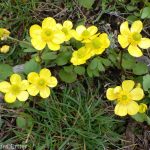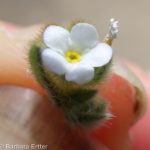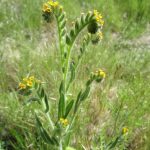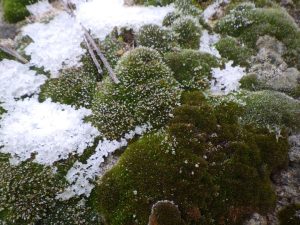
While most sensible plants hunker down during the cold winter season, awaiting the return of warmth and sunshine, there are some that flourish at this time of year. This is particularly likely in parts of the world where most of the yearly precipitation falls during the period when temperatures vacillate between freezing and thawing, with intermittent blanketing by several inches of snow; in other words, very much like lower elevations in the Boise Front. Plants that grow here have to choose: grow when there is plenty of sun and warmth, but very limited and uncertain water, or grow when there is more reliable water, even if it means spending a lot of time being frozen and snowed under? Very few animals can survive being frozen, but for many cold-adapted plants it’s no big deal, even to the extent of daily cycles of freezing and thawing. Surviving the hot, dry summer can be the greater challenge, with a variety of dormancy options to choose among.

At the head of the pack of winter-loving plants are true mosses, members of an ancient group of plants called bryophytes that were among the first lineages to colonize the earth’s surface. Lacking true roots and vascular tissue, mosses have no recourse except dormancy (or death) in the absence of abundant water. Mosses that thrive locally are those that have perfected not only the capacity to survive both freezing during the depths of winter and desiccation during the searing summer, but also the amazing ability to rapidly pick up where they left off during the intermittent periods of favorable growing conditions.
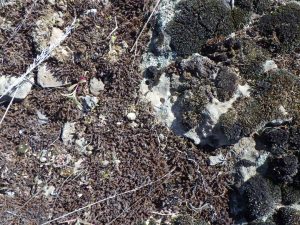
As a result, winter is actually the primary growing period for mosses in the Boise Front, including during the cool moist conditions when temperatures hover above freezing during the daytime. Not only does most vegetative growth occur at these times, when plants are bright green, but this is also when sexual reproduction takes places (by spores, not flowers and seeds). In summer, the exact same plants are dried and brown, appearing dead but actually in a state of dormancy that can be quickly broken when wet conditions return. Counterintuitively, mosses are extremely vulnerable at this stage; if artificially rehydrated in the heat of the full summer sun, plants that easily withstood both freezing and desiccation can bake to death if too hot when wet.
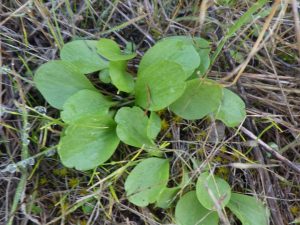
Some flowering plants also rely heavily on the intermittent favorable growing conditions during the winter months, primarily in preparation for flowering as early as possible once spring conditions arrive. Sagebrush buttercup (Ranunculus glaberrimus) is one of the champions in this regard. Plants evade the summer’s heat and drought by retreating underground as drought-tolerant swollen roots. As soon as the late fall/early winter rains saturate the soil, however, new leaves emerge and continue to grow during intermittent periods of favorable weather throughout the winter. Flower buds also develop, often opening as early as mid-February locally, coinciding with the emergence of the earliest pollinators (mostly flies).
This strategy comes with risks, however; if the rains do not begin before the ground freezes solid, and if the ground then stays frozen solid, the buttercups lose out on their prime vegetative growing season. Even worse is if prolonged freezing is coupled with an absence of protective snow cover; in such conditions, tender new leaves can easily dry out, causing the plant to skip a growing season, or even die. This happened at lower elevations in the Boise Front in the winter of 2022/23, when an unusually mild fall shifted abruptly to a hard freeze that lasted much of the winter; as a result, sagebrush buttercup flowers were less abundant than they were in more favorable years.
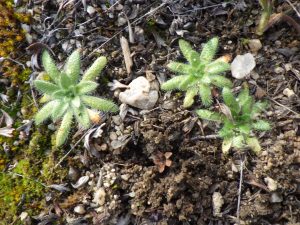
Another common strategy for local flowering plants is that of the fall-germinating annual. After a brief few months of luxuriant growth during the brief spring period when water and warmth coincide, mature plants simply throw in the towel and die rather than trying to survive the searing summer heat. Instead, they rely on resistant seeds to make it through to the next favorable growing season, which might be several years down the road. Numerous seeds develop during favorable years, fewer when conditions are less favorable, all potentially accumulating and hanging out in the subsurface seedbank until the right combination of temperature, moisture, and day length trigger germination.

If all works as planned, the reward for those enterprising annuals that germinate in fall and then tough it out over the winter months is getting a good jump on slug-a-bed species that wait until the warm days of spring before germinating. Unfortunately, some of our most invasive non-natives like cheatgrass (Bromus tectorum) and bachelor buttons (Centaurea cyanus) use this is the same strategy. Worse, they often do this even more successfully than our natives do, which get crowded out when invasive non-natives beat them out for favorable growing sites and resources. On the other hand, fall-germinating annuals, both native and non-native, are gambling that fall rains that trigger germination are not followed by a dry spell prolonged enough to cause vulnerable seedlings to shrivel and dry. While this can significantly reduce the invasive non-natives that survive until spring, it can be equally devastating to our diminishing, diminutive natives.
Take time on your winter walks to look for these plants that also love winter, while also taking care not to trample vulnerable rosettes and tender mosses. Take delight in experiencing what each season has to offer, with these early signs reminding us that the wildflowers are already getting ready for a new year!
For more information on some of our local mosses, see “Common Mosses and Ground Lichens of the Boise Foothills“. To learn more about the wonders of mosses in general, I highly recommend Gathering Moss: A Natural and Cultural History of Mosses (2003) by Robin Wall Kimmerer. This is the first book written by RWK, introducing many of the concepts and themes further developed in her inspirational book Braiding Sweetgrass (which I also highly recommend!)
